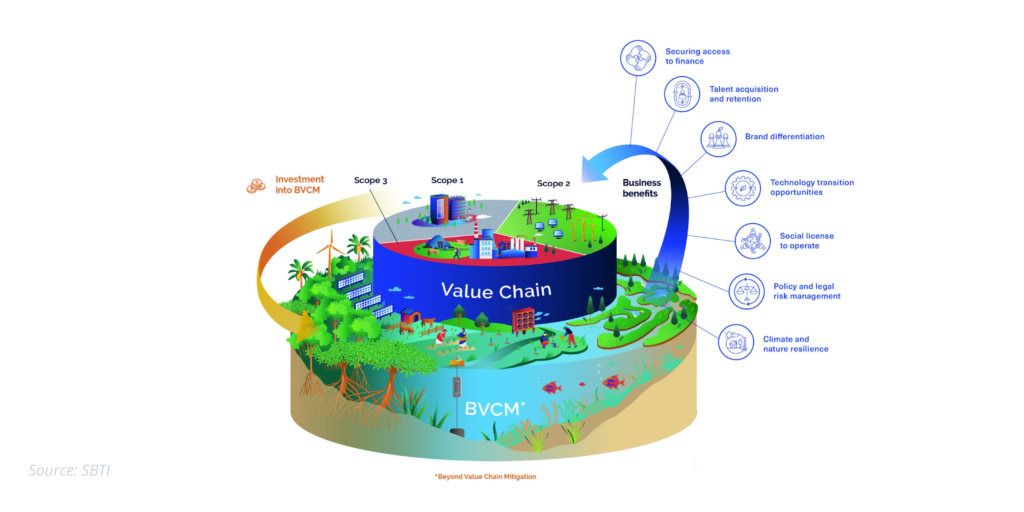To effectively combat climate change, businesses must significantly reduce emissions not only within their own walls but also throughout their extended supply networks.
The climate crisis is a pressing global issue, with the world sitting on the edge of surpassing the critical 1.5°C warming threshold. Businesses will need to play a more active part than ever, reducing emissions from their own operations but also exploring avenues to go beyond their value chains and contribute to broader climate solutions.
What is Beyond Value Chain Mitigation (BVCM)?
The Science Based Targets initiative (SBTi) introduces Beyond Value Chain Mitigation (BVCM) as a strategic mechanism for businesses to accelerate global progress towards net-zero emissions. BVCM refers to actions or investments a company undertakes outside its direct value chain that contribute to reducing greenhouse gas (GHG) emissions or removing and storing them from the atmosphere. This can encompass various activities, such as:
1/Funding innovative carbon capture and storage technologies like Direct Air Capture (DAC).
2/Supporting conservation projects focused on protecting natural carbon sinks like peatlands and mangroves.
3/Investing in renewable energy infrastructure projects in developing countries.

The SBTi’s Corporate Net-Zero Standard outlines four pillars for companies to achieve net-zero:
1 – Near-term science-based targets (SBTs): Setting ambitious 5-10 year emission reduction goals within the company’s value chain.
2 – Long-term science-based targets (SBTs): Developing long-term plans to reduce emissions within the value chain to near zero by 2050.
3 – Beyond Value Chain Mitigation (BVCM): Implementing strategies to address emissions beyond the company’s direct operations.
4 – Neutralization of residual emissions: Offsetting any remaining emissions through permanent removal and storage of carbon dioxide.
Actionable Insights that Empower Businesses to Embrace BVCM
The SBTi has released two new reports to equip companies with the knowledge and tools needed to design and implement effective BVCM strategies. These reports aim to mobilize increased corporate action towards tackling climate change.
Above and Beyond: An SBTi report on the design and implementation of BVCM
This report provides a comprehensive guide for companies on crafting and executing BVCM strategies. It explores the business case for BVCM, outlines the steps involved in making a BVCM pledge, and showcases real-world examples of companies across various sectors successfully implementing BVCM initiatives.
Beyond environmental responsibility, BVCM offers tangible benefits for companies. By actively managing climate risks and supporting the transition to a low-carbon economy, businesses can enhance their long-term resilience and profitability. Additionally, companies that embrace BVCM can attract and retain talent increasingly concerned about sustainability efforts.
The “Above and Beyond” report outlines a clear roadmap for companies to initiate their BVCM journey. This includes conducting a comprehensive assessment of the company’s environmental footprint, identifying high-impact BVCM opportunities aligned with the company’s core values and business strategy, and setting measurable targets and timelines for implementation.
Raising the Bar: An SBTi report on accelerating corporate adoption of BVCM.
This report explores the broader ecosystem of climate action stakeholders, including policymakers, civil society organizations, and academia. It examines the factors that incentivize or hinder corporate adoption of BVCM and proposes a toolbox for accelerating its implementation. Additionally, the report offers recommendations for various stakeholders, fostering a collaborative approach to scaling up corporate climate finance directed towards BVCM solutions.
The “Raising the Bar” report emphasizes that widespread corporate adoption of BVCM requires a supportive ecosystem. Policymakers can incentivize BVCM through carbon pricing mechanisms and tax breaks for sustainable investments. Civil society organizations can raise awareness about BVCM and promote best practices, while academia can provide crucial research and development on innovative climate solutions.
Why BVCM Matters?
While tackling emissions within their value chains is a critical first step, businesses have a significant opportunity to accelerate climate action by embracing Beyond Value Chain Mitigation (BVCM) strategies. Here’s a deeper dive into why BVCM matters:
Faster Progress Towards Net-Zero: The current pace of emission reductions within individual companies is simply not enough to achieve the ambitious global net-zero targets set by the Paris Agreement. BVCM allows businesses to amplify their impact by supporting emission reduction and removal activities beyond their direct control. By financing renewable energy projects in developing countries or investing in innovative carbon capture and storage technologies, companies can contribute to a larger pool of climate solutions, collectively accelerating the global shift towards a net-zero future.
Enhanced Reputation and Long-Term Value: Consumers and investors are increasingly prioritizing sustainability in their decision-making. Companies that demonstrate leadership in climate action through robust BVCM strategies can enhance their brand reputation and attract a wider pool of environmentally conscious customers and investors. Studies have shown a positive correlation between strong sustainability practices and financial performance, with companies embracing BVCM potentially securing a competitive advantage in the long run.
Unlocking New Opportunities and Mitigating Risks: Climate change poses a significant threat to businesses, disrupting supply chains, impacting resource availability, and increasing extreme weather events. BVCM allows companies to proactively manage these risks by investing in climate-resilient solutions and fostering innovation in low-carbon technologies. Additionally, by supporting the development of a sustainable and low-carbon economy, BVCM can unlock new business opportunities and markets for companies positioned at the forefront of climate solutions.
Addressing Scope 3 Emissions: A company’s environmental footprint extends beyond its direct operations (Scope 1 & 2 emissions) to encompass the emissions generated throughout its entire value chain (Scope 3 emissions). These Scope 3 emissions can be significant and often complex to address. BVCM provides businesses with a strategic tool to tackle these indirect emissions by supporting initiatives that reduce emissions across the broader supply chain or offset them through carbon removal projects.
Leveraging Collective Action: BVCM is not a solitary approach, By engaging in BVCM strategies, businesses can connect with a broader network of stakeholders committed to climate action. This can include collaboration with other companies on joint initiatives, partnerships with NGOs on specific projects, or advocacy efforts aimed at influencing policy change. This collective action strengthens the overall impact of BVCM efforts and supports a more collaborative approach to tackling the climate crisis.








